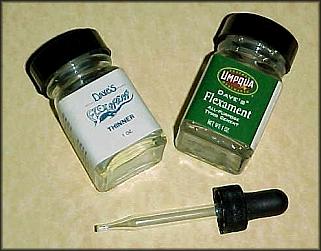You are right, I may have lost it! Maybe the fumes have gotten to
me, but, bare with me, I promise this will make sense!
It seems that through some miracle of modern chemistry, every time
I open a brand new bottle of head cement, it needs thinning within a
week or two.
Now I just know that some alchemist is out there, no doubt working
a great deal of overtime, concocting great cements with little or no open
time just to aggravate the heck out of me!
Well they are not going to get me! I will not go quietly into the abyss.
I am going to outwit them!
Yeah, I know, that may be a bit optimistic. But, we can do something
to help our cement stay thinner longer. Shame I can't use this on the old
waistline, but that is another story.
Almost every manufacturer of head cements offer compatible thinners
for their products. Now, before all of you write to me suggesting we
substitute acetone, naphtha, paint thinner, or other products, which I
agree are less expensive, please remember that many of us are not
chemists, and we have no idea what will thin Aunt Martha's Fly Goop
safely. If you know of combinations which work for you, good! By
all means, carry on. To you beginners especially, stick with the
proprietary thinners, they are safe and will work with the product they
are designed to thin.
Thinning head cement is an easy process. You just add thinner to the
cement in the proper amount to get the consistency you desire.
So you just tilt your bottle of thinner over your head cement bottle,
and proceed to pour thinner all over the place. That, which does make
it into the head cement, does so in a proportion that is probably way
out of kilter with your original intent.
Now before we proceed any further, clean up the mess you just made
trying to pour from one bottle into the other. O.K. that done, raise your
right hand and repeat after me, "I will never try that stunt again…….."
Great, now we are headed in the right direction.

If you are old enough, you no doubt remember your mother putting drops
in your eyes or up your nose to treat the malady of the day. The little tool
that helped to accomplish this task was called an eyedropper. I say was
because many things which I grew up with are at the least on the
"endangered list" if not already extinct!
Now, there are two things you want to remember in selecting an eyedropper
for dispensing thinner. The first is that the dropper should be glass. A lot
of thinner materials will eat plastic post haste.
The second thing you want to remember is NEVER suck enough thinner
into the dropper to actually come in contact with the rubber "bulb."
This little jewel is also susceptible to disintegration when some thinners
contact it. At the very least they will dry the material in it sufficiently to
cause pre-mature dry rot.
Carefully remove the lid from the head cement and the thinner. Now,
depress the little bulb on the dropper and place just the tip into the thinner.
Relax the pressure on the bulb slowly until the glass tube is perhaps one
fourth full. Place the tube of the dropper against the rim of the head cement
jar at an angle which causes the discharge area of the dropper to be located
so that when the bulb is squeezed the thinner goes into the head cement
without touching the side of the bottle. This will prevent spillage. It will also
aid in the process of stirring all of the thinner into the cement.
When you first start using the dropper for thinning, and until you get a
good feel for how much thinner to add, err on the side of less, which
in this case is better than more. Put in a "drop" or two, stir the head
cement, and then if necessary add another drop or two.
These eyedroppers are available at craft supply stores for about two
for a buck. They will save you many times their cost in aggravation
If you have any tips or techniques, send them along, most of this
material has been stolen from somebody, might as well steal your ideas
too!~ George E. Emanuel
(Chat Room Host Muddler)
|



